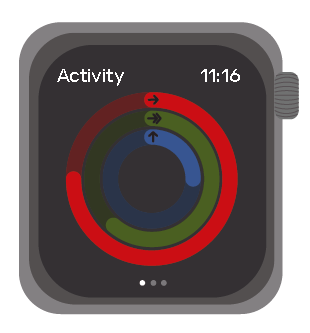Wary of the Watch
Students should not rely on fitness trackers

This past Christmas, my parents gifted me with an Apple Watch. Nine months later, I can say it is fun to review the data of my workouts and participate in challenges.
However, time has also taught me that having the knowledge of a workout’s statistics come with a price.
I feel like I have not worked hard enough when I am told that I only burned 300 calories dancing, instead of the 800-1,000 calories I have burnt on previous occasions.
My mother paces around our house at 11 p.m. because her watch tells her she only needs to burn 25 more calories until her move ring is closed.
Even my friends never forget to start a workout on their watches because “it’s not a workout unless I track it.”
The negative impacts Apple Watches can have on a person’s mentality are numerous. Students must be careful about the amount of trust and reliance they place in this piece of technology.
For those who are unfamiliar, Apple uses three concentric rings to display movement status for the day, with the goal being to close each ring. The user gets to set each ring’s total, which includes stand time, minutes spent exercising and calories burnt.
In theory, having a visual motivator sounds like it would help the wearer live a less sedentary life. However, closing these rings for many turns into an obsession, where emphasis is placed on hitting a certain number instead of enjoying fitness.
Rather than focusing on improving or carefully and gradually pushing boundaries, attention gravitates toward unrealistic goals. In addition, when these quotas are not met, Apple Watches send its users messages such as “Your Move ring is off track,” which in no way promotes listening to one’s body and actively responding to its needs.
According to Medical News Today, rest days are essential because the body replenishes its glycogen stores, which allow muscles to repair themselves and save energy for future workouts. When rest days are not taken, a depletion in glycogen leads to muscle pain and a higher risk of injury.
There are days where it is important to rest, not only for the physical benefits but also for the mental break it provides. Users forget their watches do not understand it is not realistic, or oftentimes healthy, to vigorously exercise each day.
Ultimately, Apple Watches can be helpful until the goal of working out becomes a congratulatory message instead of a healthier lifestyle. At that point, wearing the technology is not worth the risk of injury and a negative mindset around exercise.
Why should I care about how many calories I have burned during a workout if I’m proud of my body?
How much of a difference does burning 25 extra calories make?
Why should a piece of technology take away a person’s sense of accomplishment?
What students must remember is that exercising should bring joy, and when a watch begins to take that sense of fulfillment away, it is time to reevaluate whether the technology is worth constantly wearing.
Closing a colored ring should not determine your worth.

Kaitlin Green is a senior and is one out of the three publication editors. In school, Kaitlin is a captain for the Tigerette Dance Team and a student...



